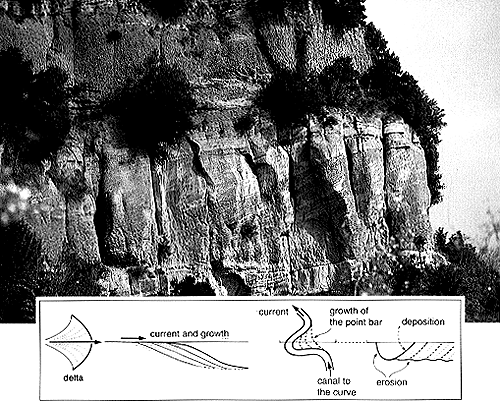
Clinostratification: laterally accreting bodies
Plate 15

Clinostratification: laterally accreting bodies
Plate 15
A tabular body made of sandstone and conglomerate beds is here sandwiched between other similar bodies: its base runs close to the bottom of the photo, and the top is marked by an alignment of shrubs. The thickness is about 7 m. The section is of Pliocene age and crops out in a mountain cliff south of Bologna (the so-called Pliocene rampart).
At first sight, the inclined bedsets look like the foresets shown in plate 14. The main difference consists in the fact that they lie on an erosional surface, not on a depositional one. To explain how this erosion occurred, think of the lateral migration of a meandering fluvial channel (inset, right-hand side). In a meander loop, erosion takes place on the outer bank and on the channel bottom, deposition on the inner side. The sloping surface of the inner bank thus accretes toward the channel axis, forming a point bar. The bar consequently grows at an angle of 60°-90° with the main flow direction. The growth is not continuous but occurs mainly during floods, when the stream discharge is at a peak. The inclined bedding formed in this way is called epsilon bedding (it was labeled with this Greek letter in a classification of cross-bedding types of the 1960s, by J. R. L. Allen). The migrating point bar "runs after" the erosional bank in order to maintain a constant section for the flow in the channel; in doing so, it encroaches on the channel bed and buries it. The lateral migration of the channel bottom incrementally creates the planar erosion surface that will form the base of the point bar body. This surface is thus the cumulative result of many erosional events; in temporal terms, it is diachronous, or time-transgressive. In other cases, similar flat surfaces are, instead, the product of instantaneous, single-event erosion.
An important implication of this mechanism should be borne in mind: an erosional surface representing a fossil channel is not necessarily channel-shaped. If a channel changes its position, either by progressive migration or sudden shifts, the geometry that will be preserved in stratigraphic sections is not the instant channel form, but the record of shifting. This record consists in a flat erosional surface in the simplest case, as seen here, or in a more irregular and complicated one (with scours, steps, terraces, etc.).
Pliocene Intra-apenninic Basin, Zena Valley, northern Apennines.